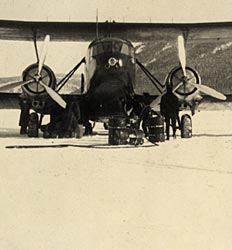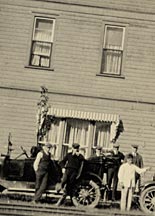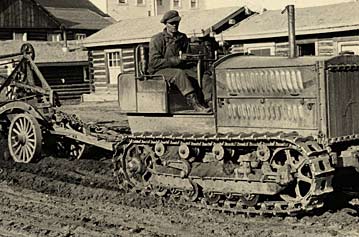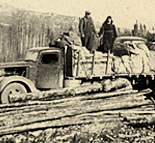Pre-1942 Roads in the Yukon
During the first quarter of the new century two developments in transportation occurred – the automobile was mass-produced and the airplane became a practical means of covering great distances in a short time. In the north, small aircraft surplus from World War I were adapted to land on rivers and lakes in winter or summer. The first airplanes to land in the Yukon were those of the New York to Nome First Alaska Air Expedition. By 1938 there were four airlines in the territory carrying passengers, freight and mail on regularly-sched uled flights within and to the "outside". The airplane had become a popular, if expensive, way to overcome isolation and, conversely, was used by big game hunters, trappers and prospectors to reach remote areas.
Skagway-based White Pass Airways’ Curtiss Condor NC12371 being fuelled and loaded at Dawson Airport. This was the largest passenger plane in Canada in 1935. This aircraft later became Whitehorse-based with the British Yukon Navigation Co. Air Service and registered CF-BQN. ca. late 1930s. (view more details)

Group of people standing by vintage automobiles parked in front of the Caribou Hotel in Carcross. (view more details)

The proliferation of automobiles put pressure on all levels of Government to build and maintain roads that could handle the speed of a motorized vehicle. A network of roads gradually developed within small communities, mainly linking mines with towns. A winter road known as the Overland Trail connected Dawson City and Whitehorse - a distance of 330 miles (500 km). Built in 1902 by the White Pass and Yukon Route, it was used to transport passengers, supplies and mail in the wintertime and in shoulder seasons when the river was frozen. (During the summer months river travel with sternwheelers took over these functions.) Roadhouses were built about every 20 miles (32 km) to provide food and lodging for passengers. The trip took five days with horse drawn wagons or sleighs. The first car went over the Trail in 1912 and by 1923-24 trucks and cat-trains had replaced horses for the most part.
...Tracked vehicles, introduced in the 1920s, could haul freight in all seasons, with greater tonnage than dogs or horses, revolutionizing transportation in the Yukon Territory. (view more details)

A rough wagon road of 150 miles (230 km) was built from Whitehorse to Silver City on the shore of Kluane Lake in 1904 by the Territorial Government. This road supported the developing mine industry in Kluane, transporting people and supplies. In the 1920s cars and trucks were using the road including those of Frank Harbottle, who owned a small transportation company. The road was described in 1929 by the Superintendent of Works and Buildings, J.H. McNeill, as "comparatively easy when the surface is dry, but becomes rather difficult when wet owing to the gumbo nature of the soil".



